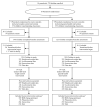Hip-Hop to Health Jr. Obesity Prevention Effectiveness Trial: postintervention results
- PMID: 21193852
- PMCID: PMC3775499
- DOI: 10.1038/oby.2010.314
Hip-Hop to Health Jr. Obesity Prevention Effectiveness Trial: postintervention results
Abstract
The preschool years offer an opportunity to interrupt the trajectory toward obesity in black children. The Hip-Hop to Health Jr. Obesity Prevention Effectiveness Trial was a group-randomized controlled trial assessing the feasibility and effectiveness of a teacher-delivered weight control intervention for black preschool children. The 618 participating children were enrolled in 18 schools administered by the Chicago Public Schools. Children enrolled in the nine schools randomized to the intervention group received a 14-week weight control intervention delivered by their classroom teachers. Children in the nine control schools received a general health intervention. Height and weight, physical activity, screen time, and diet data were collected at baseline and postintervention. At postintervention, children in the intervention schools engaged in more moderate-to-vigorous physical activity (MVPA) than children in the control schools (difference between adjusted group means = 7.46 min/day, P = 0.02). Also, children in the intervention group had less total screen time (-27.8 min/day, P = 0.05). There were no significant differences in BMI, BMI Z score, or dietary intake. It is feasible to adapt an obesity prevention program to be taught by classroom teachers. The intervention showed positive influences on physical activity and screen time, but not on diet. Measuring diet and physical activity in preschool children remains a challenge, and interventions delivered by classroom teachers require both intensive initial training and ongoing individualized supervision.
Figures

Similar articles
-
Hip-Hop to Health Jr. Randomized Effectiveness Trial: 1-Year Follow-up Results.Am J Prev Med. 2016 Feb;50(2):136-44. doi: 10.1016/j.amepre.2015.07.008. Epub 2015 Sep 16. Am J Prev Med. 2016. PMID: 26385162 Free PMC article. Clinical Trial.
-
Power-up: a collaborative after-school program to prevent obesity in African American children.Prog Community Health Partnersh. 2011 Winter;5(4):363-73. Prog Community Health Partnersh. 2011. PMID: 22616204 Free PMC article.
-
Hip-Hop to Health Jr. for Latino preschool children.Obesity (Silver Spring). 2006 Sep;14(9):1616-25. doi: 10.1038/oby.2006.186. Obesity (Silver Spring). 2006. PMID: 17030973 Clinical Trial.
-
[Simple obesity in children. A study on the role of nutritional factors].Med Wieku Rozwoj. 2006 Jan-Mar;10(1):3-191. Med Wieku Rozwoj. 2006. PMID: 16733288 Review. Polish.
-
The impact of Allied Health Professionals on the primary and secondary prevention of obesity in young children: A scoping review.Clin Obes. 2023 Jun;13(3):e12571. doi: 10.1111/cob.12571. Epub 2022 Nov 30. Clin Obes. 2023. PMID: 36451267
Cited by
-
Childhood Obesity Evidence Base Project: A Systematic Review and Meta-Analysis of a New Taxonomy of Intervention Components to Improve Weight Status in Children 2-5 Years of Age, 2005-2019.Child Obes. 2020 Sep;16(S2):S221-S248. doi: 10.1089/chi.2020.0139. Child Obes. 2020. PMID: 32936038 Free PMC article.
-
Effect of a School-Based Intervention on Nutritional Knowledge and Habits of Low-Socioeconomic School Children in Israel: A Cluster-Randomized Controlled Trial.Nutrients. 2016 Apr 21;8(4):234. doi: 10.3390/nu8040234. Nutrients. 2016. PMID: 27110817 Free PMC article. Clinical Trial.
-
Web-Based Program Exposure and Retention in the Families Improving Together for Weight Loss Trial.Ann Behav Med. 2019 Mar 20;53(4):399-404. doi: 10.1093/abm/kay047. Ann Behav Med. 2019. PMID: 30892641 Free PMC article. Clinical Trial.
-
Implementing Appetite to Play at scale in British Columbia: Evaluation of a Capacity-Building Intervention to Promote Physical Activity in the Early Years.Int J Environ Res Public Health. 2020 Feb 11;17(4):1132. doi: 10.3390/ijerph17041132. Int J Environ Res Public Health. 2020. PMID: 32053916 Free PMC article.
-
Association between childcare educators' practices and preschoolers' physical activity and dietary intake: a cross-sectional analysis.BMJ Open. 2017 May 30;7(5):e013657. doi: 10.1136/bmjopen-2016-013657. BMJ Open. 2017. PMID: 28559455 Free PMC article.
References
-
- Ogden CL, Yanovski SZ, Carroll MD, Flegal KM. The epidemiology of obesity. Gastroenterology. 2007;132(6):2087–2102. - PubMed
-
- Barlow SE, Expert Committee Expert committee recommendations regarding the prevention, assessment, and treatment of child and adolescent overweight and obesity: summary report. Pediatrics. 2007;120(Suppl 4):S164–192. - PubMed
-
- Kuczmarski RJ, Ogden CL, Guo SS, Grummer-Strawn LM, Flegal KM, Mei Z, et al. CDC growth charts for the United States: methods and development. Vital Health Stat. 2000;2002;11(246):1–190. - PubMed
-
- Ogden CL, Carroll MD, Curtin LR, Lamb MM, Flegal KM , 2007-2008. JAMA. 2010;303(3):242–249. - PubMed
-
- Fitzgibbon ML, Stolley MR, Dyer AR, Van Horn L, KauferChristoffel K. A community-based obesity prevention program for minority children: rationale and study design for Hip-Hop to Health Jr. Prev Med. 2002;34:289–297. - PubMed
Publication types
MeSH terms
Grants and funding
LinkOut - more resources
Full Text Sources
Medical

